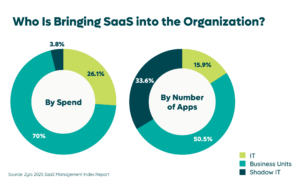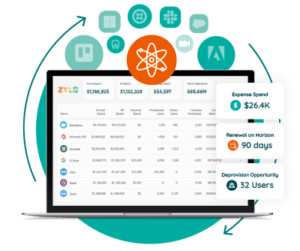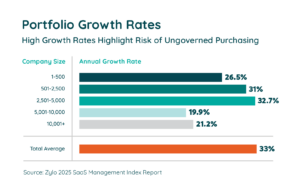
Zoom License Cost 2026: Which Plan Offers the Best Value for Your…
Table of Contents ToggleSaaS Ousts Software Audits, But Presents New ChallengesWhy...
Back
Back
Search for Keywords...
Blog

06/08/2021
Table of Contents
When on-premises software was king, software audits were a common occurrence — and a dreaded one at that.
On-premises software vendors routinely conducted these audits to ensure an organization was using software in compliance with their contract. This included measuring actual usage of the software and comparing that to what the company was paying for.
Software audits could spring up at any time, seemingly out of nowhere. And preparing for them took time and effort — often pulling team members away from other important tasks.
When things went south, there were costly consequences. If a vendor found that a company wasn’t using their software as outlined in their contract, the company could run into legal issues and penalties to the tune of millions of dollars.
But the rise of SaaS has had a big impact on the software audit.
At many organizations, SaaS is rapidly growing — and replacing on-premise software. And it seems this growth won’t slow down anytime soon. In their State of the Cloud 2021, Bessemer Venture Partners predicted that within the next three years, the cloud will be the dominant delivery model for all software.
That prediction actually came to fruition according to analyst IDC. In 2022, for the first time ever, more money was spent on SaaS than on-premises software.
The great news is, the dreaded software audit isn’t a concern with SaaS. That’s because SaaS vendors have ongoing visibility into how you’re using their software, and there’s typically no way of getting around the license terms. If you want extended access — for example, additional licenses or units — you’ve got to pay for it.
But that doesn’t mean audits should be a thing of the past. In fact, if your organization is investing heavily in SaaS, it’s essential to regularly conduct internal SaaS audits. If you don’t, you’re creating unnecessary costs and risk for your organization.
Chances are, your organization has more SaaS applications than you think – and you aren’t alone. Our SaaS Management Index found that on average, most organizations consistently underestimate how many SaaS applications they have by two to three times!
Why does perception differ so much from reality?
Largely, because SaaS is easy to acquire. On-premises software typically goes through a formal vetting process that involves the IT and procurement teams. Yet, SaaS is often purchased by individuals and business units throughout the organization — often via credit card. In fact, business units and employees combined make up 74% of SaaS spend and a whopping 84% of application quantity.

The fact that SaaS is easy to acquire can be a good thing; it means employees can quickly get access to the tools they need to be successful. But this ease of acquisition can also cause a lot of problems for organizations.
For starters, SaaS applications purchased via credit card don’t go through a formal vetting process to ensure they’re compliant and secure. That’s bad news as these rogue, unknown applications create risk for your organization. And that risk can lead to costly consequences. According to IBM Security’s annual Cost of a Data Breach Report, the average data breach in the United States costs $4.88M.

SaaS growth, when left unmanaged, also creates unnecessary costs. One example is when the exact same application is purchased by multiple people or teams throughout the organization. And duplicate SaaS subscriptions are more common than you might think. At the average organization, 90 SaaS applications are purchased by more than one employee.
When SaaS is purchased throughout the organization, it can also lead to redundant applications. That means your organization is paying for multiple tools that essentially do the exact same thing.
A SaaS audit can help you regain control of SaaS growth at your organization and be a great first step toward more effective SaaS management. And when you proactively manage Saas, you’re in a better position to control the costs and risks associated with it.
We’ve established that a SaaS audit is a great way to start better managing SaaS. But what exactly is a SaaS audit?
As the name suggests, a SaaS software audit is an internal review of all SaaS applications in your organization. It sets the foundation for a more effective SaaS management strategy that’ll empower you to cut risk and costs.
 When done right, a SaaS audit will allow you to:
When done right, a SaaS audit will allow you to:
One option is to conduct a manual, internal SaaS audit. Such an audit might involve surveying each department to discover all SaaS applications in use, and then logging the key details for each application into a spreadsheet.
But the average organization has 275 SaaS applications, which means this process could easily take months. What’s more, that spreadsheet is sure to get outdated quickly as the typical company sees seven new applications enter its environment. Over the course of the year, if left unmanaged, your portfolio would grow 33%.

A better option is to work with a SaaS Management vendor to conduct a SaaS audit. These vendors leverage SaaS software audit tools to help organizations discover all SaaS — and leverage insights to optimize their SaaS portfolios.
Typically, the SaaS audit process takes just two to three weeks. And there’s no heavy lifting on your part; you’ve just got to provide your Accounts Payable and Expense data. Once your SaaS audit is complete, you can choose to roll the process into a full implementation with the SaaS management vendor.
As SaaS overtakes on-premises software, software audits are getting a lot less common. But that doesn’t mean audits are a thing of the past. Today, SaaS audits are a must for organizations looking to cut the risk and costs associated with unmanaged SaaS growth.
Start taking control of SaaS growth at your organization. Learn how Zylo’s Discovery & Inventory solution helps you audit and uncover all your SaaS.

Table of Contents ToggleSaaS Ousts Software Audits, But Presents New ChallengesWhy...

Table of Contents ToggleSaaS Ousts Software Audits, But Presents New ChallengesWhy...

Table of Contents ToggleKey Themes That Shaped SaaS Management in 20251....

Table of Contents ToggleSaaS Ousts Software Audits, But Presents New ChallengesWhy...
| Cookie | Duration | Description |
|---|---|---|
| cookielawinfo-checkbox-analytics | 11 months | This cookie is set by GDPR Cookie Consent plugin. The cookie is used to store the user consent for the cookies in the category "Analytics". |
| cookielawinfo-checkbox-functional | 11 months | The cookie is set by GDPR cookie consent to record the user consent for the cookies in the category "Functional". |
| cookielawinfo-checkbox-necessary | 11 months | This cookie is set by GDPR Cookie Consent plugin. The cookies is used to store the user consent for the cookies in the category "Necessary". |
| cookielawinfo-checkbox-others | 11 months | This cookie is set by GDPR Cookie Consent plugin. The cookie is used to store the user consent for the cookies in the category "Other. |
| cookielawinfo-checkbox-performance | 11 months | This cookie is set by GDPR Cookie Consent plugin. The cookie is used to store the user consent for the cookies in the category "Performance". |
| viewed_cookie_policy | 11 months | The cookie is set by the GDPR Cookie Consent plugin and is used to store whether or not user has consented to the use of cookies. It does not store any personal data. |
